Honda Accord Hybrid (2022 year). Manual in english — page 35

559
uu
Replacing Light Bulbs
u
Taillights, Brake Lights
*
, and Back-Up Light Bulbs
Main
tenan
ce
2.
Turn the socket clockwise and remove it.
3.
Remove the old bulb and insert a new bulb.
Bulb
Socket
Passenger side
560
uu
Replacing Light Bulbs
u
Rear License Plate Light
Main
tenan
ce
Rear License Plate Light
Rear license plate light is LED type. Have an authorized Honda dealer inspect and
replace the light assembly.
High-Mount Brake Light
High-mount brake light is LED type. Have an authorized Honda dealer inspect and
replace the light assembly.
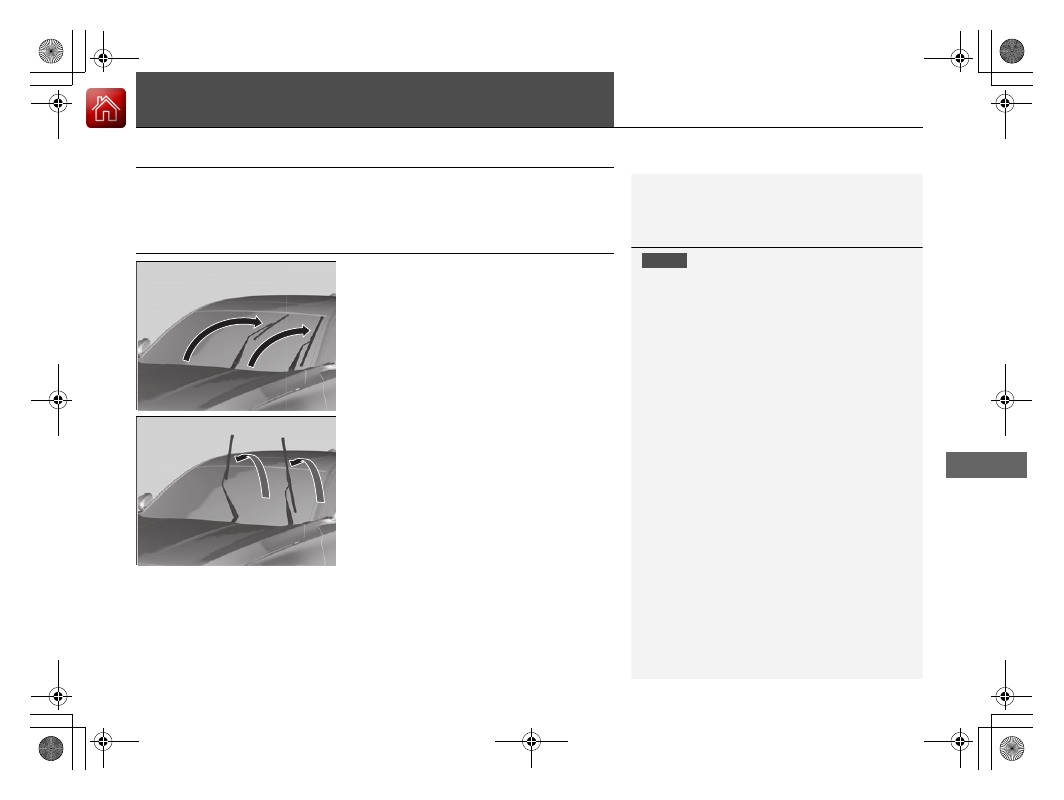
561
Continued
Main
tenan
ce
Checking and Maintaining Wiper Blades
Checking Wiper Blades
If the wiper blade rubber has deteriorated, it will leave streaks, become noisy, and
the hard surfaces of the blade may scratch the window glass.
Changing the Wiper Blade Rubber
1.
Set the power mode to VEHICLE OFF.
2.
While holding the wiper switch in the
MIST
position, set the power mode to ON,
then to VEHICLE OFF.
u
Both wiper arms are set to the
maintenance position as shown in the
image.
3.
Lift the driver side wiper arm first, then the
passenger side.
1
Changing the Wiper Blade Rubber
NOTICE
Avoid dropping the wiper arm onto the windshield, it
may damage the wiper arm and/or the windshield.

562
uu
Checking and Maintaining Wiper Blades
u
Changing the Wiper Blade Rubber
Main
tenan
ce
4.
Press up on and hold the tab, then slide
the holder off the wiper arm.
5.
Pull the end of the wiper blade in the
direction of the arrow in the image until it
is out of the holder’s end cap.
6.
Pull the wiper blade in the opposite
direction to slide it out of the holder.
Tab
Wiper Blade
End Cap At
The Bottom
Wiper Blade
Holder
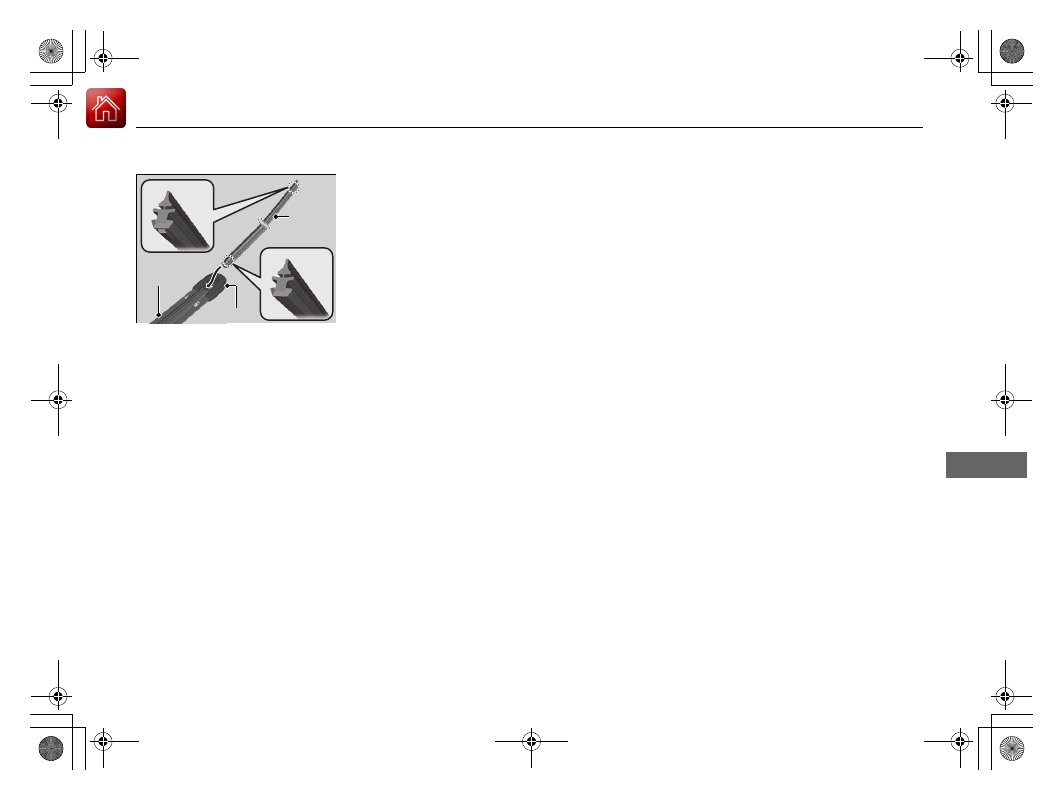
563
uu
Checking and Maintaining Wiper Blades
u
Changing the Wiper Blade Rubber
Main
tenan
ce
7.
Insert the flat side of the new wiper blade
onto the bottom part of the holder. Insert
the blade all the way.
8.
Install the end of the wiper blade into the
cap.
9.
Slide the holder onto the wiper arm until it
locks.
10.
Lower the passenger side wiper arm first,
then the driver side.
11.
Set the power mode to ON and hold the
wiper switch in the
MIST
position until
both wiper arms return to the standard
position.
Holder
Wiper
Blade
Cap
564
Main
tenan
ce
Checking and Maintaining Tires
Checking Tires
To safely operate your vehicle, your tires must be of the proper type and size, in
good condition with adequate tread, and properly inflated.
■
Inflation guidelines
Properly inflated tires provide the best combination of handling, tread life, and
comfort. Refer to the driver’s doorjamb label or specifications page for the specified
pressure.
Underinflated tires wear unevenly, adversely affect handling and fuel economy, and
are more likely to fail from overheating.
Overinflated tires make your vehicle ride harshly, are more prone to road hazards,
and wear unevenly.
Every day before you drive, look at each of the tires. If one looks lower than the
others, check the pressure with a tire gauge.
At least once a month or before long trips, use a gauge to measure the pressure in
all tires. Even tires in good condition can lose 1–2 psi (10–20 kPa, 0.1–0.2 kgf/cm
2
)
per month.
■
Inspection guidelines
Every time you check inflation, also examine the tires and valve stems. Look for:
•
Bumps or bulges on the side or in the tread. Replace the tire if you find any cuts,
splits, or cracks in the side of the tire. Replace it if you see fabric or cord.
•
Remove any foreign objects and inspect for air leaks.
•
Uneven tread wear. Have a dealer check the wheel alignment.
•
Excessive tread wear.
2
•
Cracks or other damage around valve stem.
1
Measure the air pressure when tires are cold. This
means the vehicle has been parked for at least three
hours, or driven less than 1 mile (1.6 km). If
necessary, add or release air until the specified
pressure is reached.
If checked when hot, tire pressure can be as much as
4–6 psi (30–40 kPa, 0.3–0.4 kgf/cm
2
) higher than if
checked when cold.
Whenever tire pressure is adjusted, you must
calibrate the TPMS.
2
Have a dealer check the tires if you feel a consistent
vibration while driving. New tires and any that have
been removed and reinstalled should be properly
balanced.
3
WARNING
Using tires that are excessively worn or
improperly inflated can cause a crash in
which you can be seriously hurt or killed.
Follow all instructions in this owner’s
manual regarding tire inflation and
maintenance.
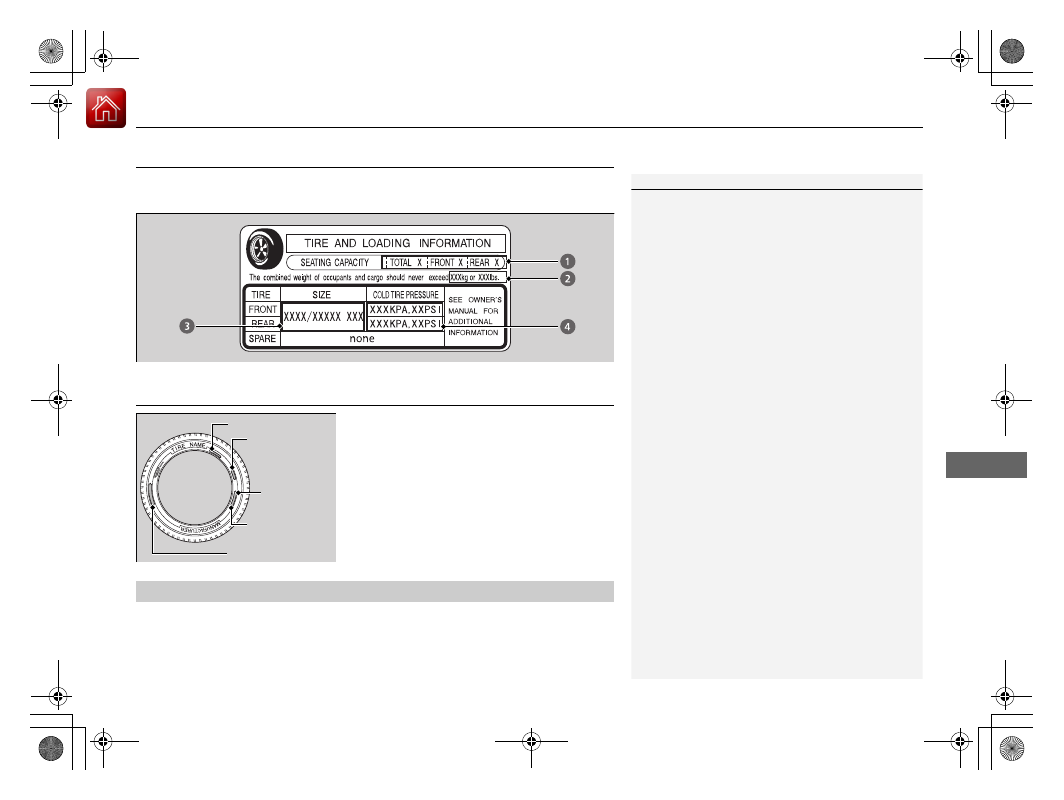
565
uu
Checking and Maintaining Tires
u
Tire and Loading Information Label
Continued
Main
tenan
ce
Tire and Loading Information Label
The label attached to the driver’s doorjamb provides necessary tire and loading
information.
Tire Labeling
The tires that came on your vehicle have a
number of markings. Those you should be
aware of are described as shown.
Whenever tires are replaced, they should be replaced with tires of the same size.
1
Tire and Loading Information Label
The tire and loading information label attached to the
driver’s doorjamb contains:
a
The number of people your vehicle can carry.
b
The total weight your vehicle can carry. Do not
exceed this weight.
c
The original tire sizes for front, rear, and spare.
d
The proper cold tire pressure for front, rear, and
spare.
Label
Example
Example
Tire Size
Tire
Identification
Number (TIN)
Maximum
Tire Load
Maximum
Tire Pressure
Tire Size
■
Tire Sizes
1
Following is an example of tire size with an
explanation of what each component means.
225/50R17 94V
225: Tire width in millimeters.
50: Aspect ratio (the tire’s section height as a
percentage of its width).
R: Tire construction code (R indicates radial).
17: Rim diameter in inches.
94: Load index (a numerical code associated with the
maximum load the tire can carry).
V: Speed symbol (an alphabetical code indicating the
maximum speed rating).
uu
Checking and Maintaining Tires
u
Tire Labeling
566
Main
tenan
ce
The tire identification number (TIN) is a group of numbers and letters that look like
the example in the side column. TIN is located on the sidewall of the tire.
Cold Tire Pressure
– The tire air pressure when the vehicle has been parked for at
least three hours or driven less than 1 mile (1.6 km).
Load Rating
– Means the maximum load that a tire is rated to carry for a given
inflation pressure.
Maximum Inflation Pressure
– The maximum tire air pressure that the tire can
hold.
Maximum Load Rating
– Means the load rating for a tire at the maximum
permissible inflation pressure for that tire.
Recommended Inflation Pressure
– The cold tire inflation pressure
recommended by the manufacturer.
Treadwear Indicators (TWI)
– Means the projections within the principal grooves
designed to give a visual indication of the degrees of wear of the tread.
■
Tire Identification Number (TIN)
■
Glossary of Tire Terminology
1
Tire Identification Number (TIN)
DOT B97R FW6X 2209
DOT: This indicates that the tire meets all
requirements of the U.S. Department of
Transportation.
B97R: Manufacturer’s identification mark.
FW6X: Tire type code.
22 09: Date of manufacture.
Year
Week
567
uu
Checking and Maintaining Tires
u
DOT Tire Quality Grading (U.S. Vehicles)
Continued
Main
tenan
ce
DOT Tire Quality Grading (U.S. Vehicles)
The tires on your vehicle meet all U.S. Federal Safety
Requirements. All tires are also graded for treadwear, traction,
and temperature performance according to Department of
Transportation (DOT) standards. The following explains these
gradings.
Quality grades can be found where applicable on the tire sidewall
between tread shoulder and maximum section width.
The treadwear grade is a comparative rating based on the wear
rate of the tire when tested under controlled conditions on a
specified government test course. For example, a tire graded 150
would wear one and one-half (1 1/2) times as well on the
government course as a tire graded 100. The relative performance
of tires depends upon the actual conditions of their use, however,
and may depart significantly from the norm due to variations in
driving habits, service practices and differences in road
characteristics and climate.
■
Uniform Tire Quality Grading
■
Treadwear
1
For example:
Treadwear 200
Traction AA
Temperature A
All passenger car tires must conform
to Federal Safety Requirements in
addition to these grades.
uu
Checking and Maintaining Tires
u
DOT Tire Quality Grading (U.S. Vehicles)
568
Main
tenan
ce
The traction grades, from highest to lowest, are AA, A, B, and C.
Those grades represent the tire’s ability to stop on wet pavement
as measured under controlled conditions on specified
government test surfaces of asphalt and concrete. A tire marked
C may have poor traction performance.
The temperature grades are A (the highest), B, and C,
representing the tire’s resistance to the generation of heat and its
ability to dissipate heat when tested under controlled conditions
on a specified indoor laboratory test wheel. Sustained high
temperature can cause the material of the tire to degenerate and
reduce tire life, and excessive temperature can lead to sudden tire
failure. The grade C corresponds to a level of performance which
all passenger car tires must meet under the Federal Motor Vehicle
Safety Standard No. 109. Grades B and A represent higher levels
of performance on the laboratory test wheel than the minimum
required by law.
■
Traction
■
Temperature
1
Warning: The traction grade
assigned to this tire is based on
straight-ahead braking traction tests,
and does not include acceleration,
cornering, hydroplaning, or peak
traction characteristics.
1
Warning: The temperature grade for
this tire is established for a tire that is
properly inflated and not
overloaded. Excessive speed,
underinflation, or excessive loading,
either separately or in combination,
can cause heat buildup and possible
tire failure.

569
uu
Checking and Maintaining Tires
u
Wear Indicators
Main
tenan
ce
Wear Indicators
The groove where the wear indicator is
located is about 1/16 inch (about 1.6 mm)
shallower than elsewhere on the tire. If the
tread has worn so that the indicator is
exposed, replace the tire.
Worn out tires have poor traction on wet
roads.
Tire Service Life
The life of your tires is dependent on many factors, including driving habits, road
conditions, vehicle loading, inflation pressure, maintenance history, speed, and
environmental conditions (even when the tires are not in use).
In addition to regular inspections and inflation pressure maintenance, it is
recommended that you have annual inspections performed once the tires reach five
years old. All tires should be removed from service after 10 years from the date of
manufacture, regardless of their condition or state of wear.
1
High speed driving
We recommend that you do not drive faster than the
posted speed limits and conditions allow. If you drive
at sustained high speeds (over 99 mph or 160 km/h),
adjust the cold tire pressures as shown below to
avoid excessive heat buildup and sudden tire failure.
Tire Size
225/50R17 94V
Pressure
Front: 35 psi (240 kPa, 2.4 kgf/cm
2
)
Rear: 33 psi (230 kPa, 2.3 kgf/cm
2
)
Tire Size
235/40R19 96V
Pressure
Front: 36 psi (250 kPa, 2.5 kgf/cm
2
)
Rear: 36 psi (250 kPa, 2.5 kgf/cm
2
)
Models with 225/50R17 tires
Models with 235/40R19 tires
Example of a Wear
Indicator mark
570
uu
Checking and Maintaining Tires
u
Tire and Wheel Replacement
Main
tenan
ce
Tire and Wheel Replacement
Replace your tires with radials of the same size, load range, speed rating, and
maximum cold tire pressure rating (as shown on the tire’s sidewall). Using tires of a
different size or construction can cause certain vehicle systems such as the ABS and
Vehicle Stability Assist
TM
(VSA
®
) system to work incorrectly.
It is best to replace all four tires at the same time. If that isn’t possible, replace the
front or rear tires in pairs.
Make sure that the wheel’s specifications match those of the original wheels.
1
3
WARNING
Installing improper tires on your vehicle can
affect handling and stability. This can cause
a crash in which you can be seriously hurt or
killed.
Always use the size and type of tires
recommended in this owner’s manual.
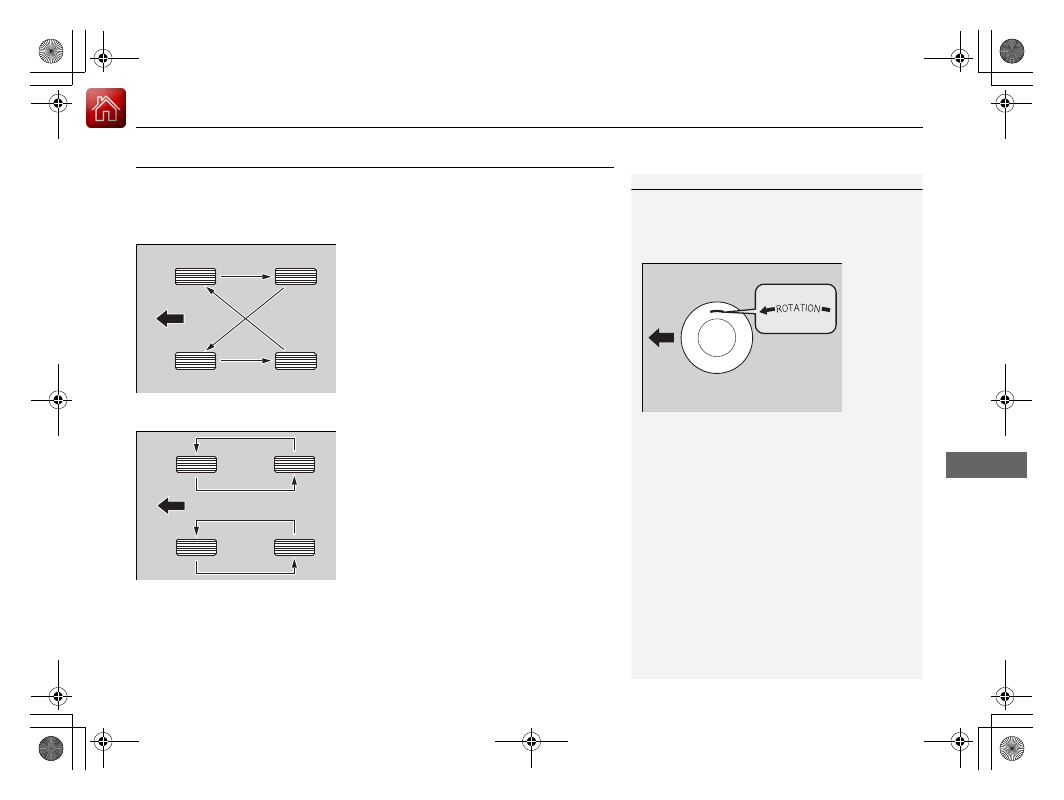
571
uu
Checking and Maintaining Tires
u
Tire Rotation
Main
tenan
ce
Tire Rotation
Rotating tires according to the maintenance messages on the driver information
interface helps to distribute wear more evenly and increase tire life.
■
Tires without rotation marks
Rotate the tires as shown here.
■
Tires with rotation marks
Rotate the tires as shown here.
1
Tires with directional tread patterns should only be
rotated front to back (not from one side to the other).
Directional tires should be mounted with the rotation
indication mark facing forward, as shown below.
Whenever tires are rotated, you must calibrate the
TPMS.
2
P. 439
Front
Direction Mark
Front
Front

572
uu
Checking and Maintaining Tires
u
Winter Tires
Main
tenan
ce
Winter Tires
If driving on snowy or frozen roads, mount all season marked
M+S
tires, snow tires,
or tire chains; reduce speed; and maintain sufficient distance between vehicles when
driving.
Be particularly careful when operating the steering wheel or brakes to prevent
skidding.
Use tire chains, snow tires, or all season tires when necessary or according to the
law.
When mounting, refer to the following points.
For winter tires:
•
Select the size and load ranges that are the same as the original tires.
•
Mount the tires to all four wheels.
For tire chains:
•
Install them on the front tires only.
•
Because your vehicle has limited tire clearance, we strongly recommend using the
chains listed below:
•
Follow the chain manufacturer’s instruction when installing. Mount them as
tightly as you can.
•
Check that the chains do not touch the brake lines or suspension.
•
Drive slowly.
Cable-type: SCC Radial Chain SC1036
Cable-type: (Not available)
1
NOTICE
Traction devices that are the wrong size or improperly
installed can damage your vehicle’s brake lines,
suspension, body, and wheels. Stop driving if they are
hitting any part of the vehicle.
When tire chains are mounted, follow the chain
manufacture’s instructions regarding vehicle
operational limits.
If your vehicle is equipped with summer tires, be
aware that these tires are not designed for winter
driving conditions. For more information, contact a
dealer.
3
WARNING
Using the wrong chains, or not properly
installing chains, can damage the brake
lines and cause a crash in which you can be
seriously injured or killed.
Follow all instructions in this owner’s
manual regarding the selection and use of
tire chains.
Models with 225/50R17 tires
Models with 235/40R19 tires
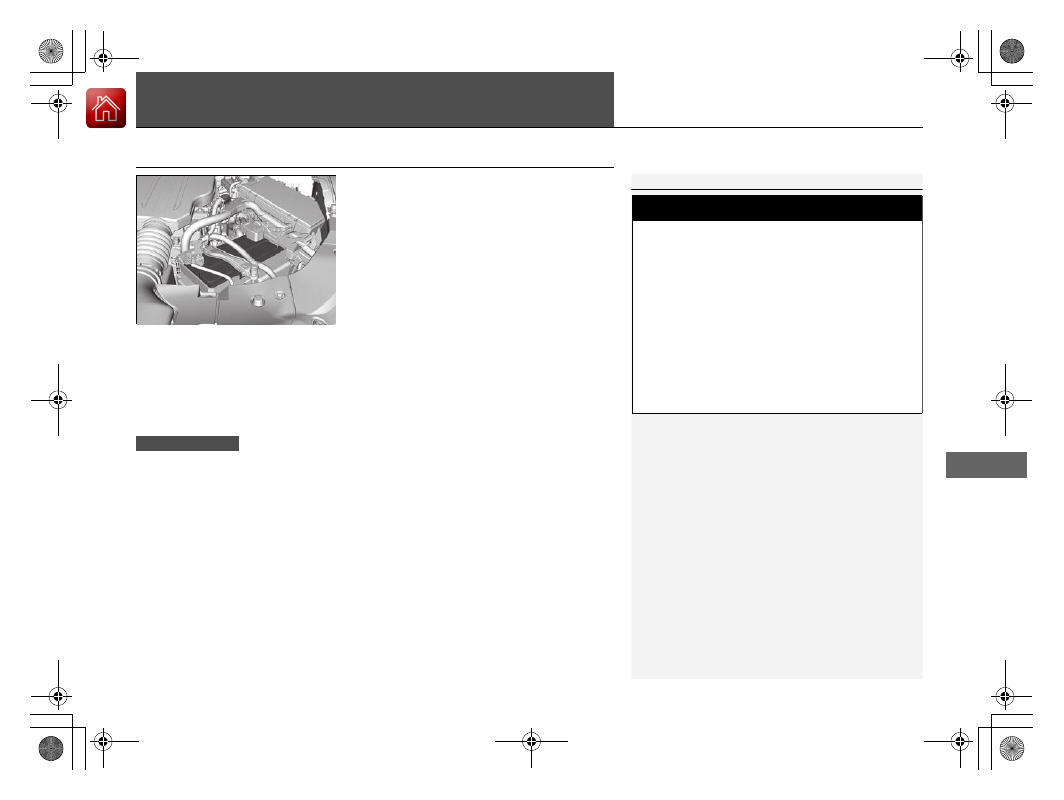
573
Main
tenan
ce
12-Volt Battery
Checking the 12-Volt Battery
The condition of the battery is monitored by a
sensor located on the negative terminal of the
battery. If there is a problem with this sensor,
the driver information interface will display a
warning message. If this happens, have your
vehicle inspected by a dealer.
Check the battery terminals for corrosion
monthly.
If your vehicle’s battery is disconnected or goes dead:
•
The audio system is disabled.
2
•
The clock resets.
2
•
The immobilizer system needs to be reset.
2
1
WARNING:
Battery post, terminals,
and related accessories contain lead
and lead compounds.
Wash your hands after handling.
3
WARNING
The battery gives off explosive hydrogen
gas during normal operation.
A spark or flame can cause the battery to
explode with enough force to kill or
seriously hurt you.
When conducting any battery
maintenance, wear protective clothing and
a face shield, or have a skilled technician do
it.
Canadian models
574
uu
12-Volt Battery
u
Charging the 12-Volt Battery
Main
tenan
ce
Charging the 12-Volt Battery
Disconnect both battery cables to prevent damaging your vehicle’s electrical system.
Always disconnect the negative (–) cable first, and reconnect it last.
1
When you find corrosion, clean the battery terminals
by applying a baking powder and water solution.
Clean the terminals with a damp towel. Cloth/towel
dry the battery. Coat the terminals with grease to
help prevent future corrosion.
When replacing the battery, the replacement must be
of the same specifications.
Consult a dealer for more information.
The indicators for the Adaptive Cruise Control (ACC)
with Low Speed Follow, safety support, Vehicle
Stability Assist
TM
(VSA
®
) system, Vehicle Stability
Assist
TM
(VSA
®
) OFF, and Low Tire Pressure/TPMS may
come on after reconnecting the 12-volt battery. Drive
a short distance at more than 12 mph (20 km/h). The
indicators should go off. If they do not, have your
vehicle checked by a dealer.

Нет комментариевНе стесняйтесь поделиться с нами вашим ценным мнением.
Текст